Foreign Investment in Australia on Economic PDF
VerifiedAdded on 2020/12/18
|21
|4053
|448
AI Summary
Contribute Materials
Your contribution can guide someone’s learning journey. Share your
documents today.
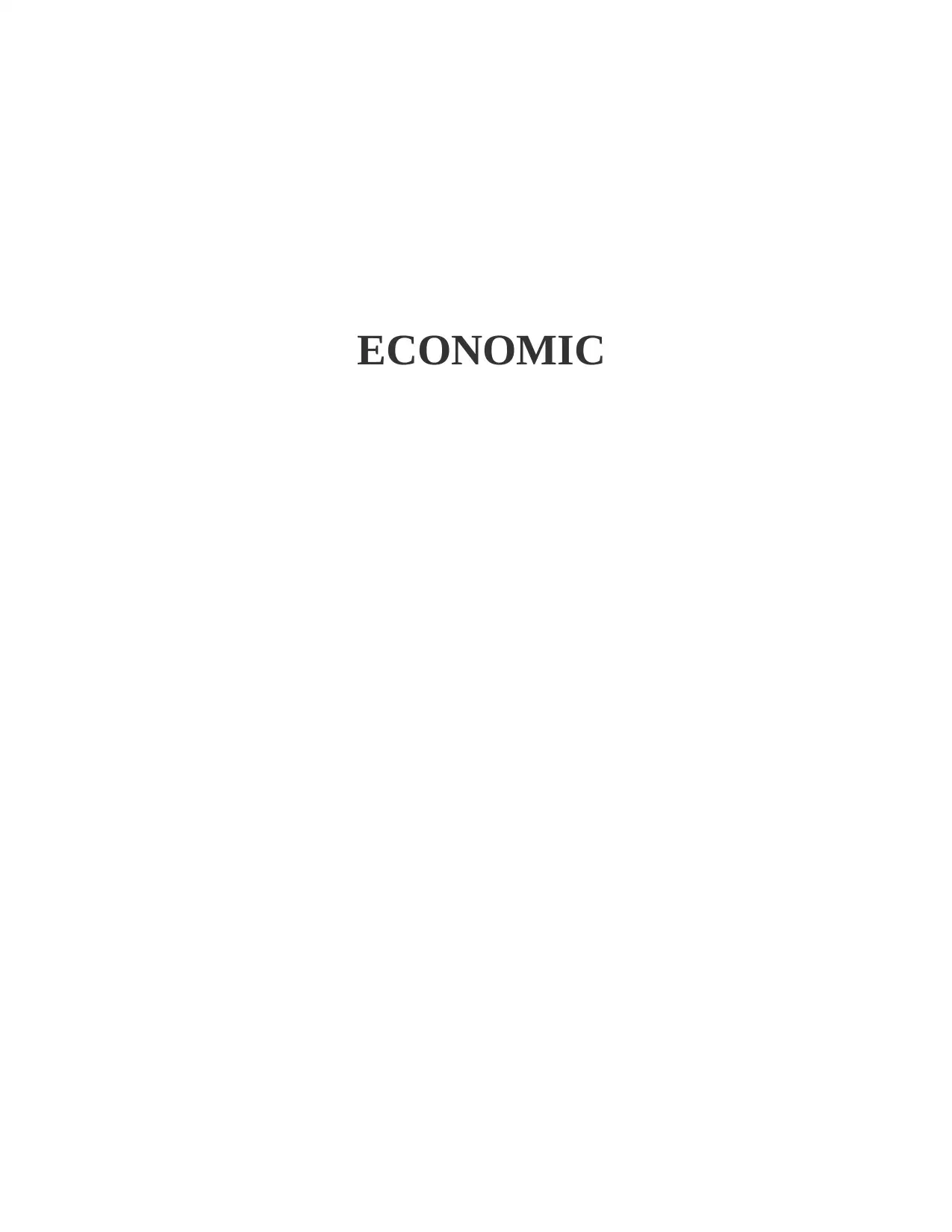
ECONOMIC
Secure Best Marks with AI Grader
Need help grading? Try our AI Grader for instant feedback on your assignments.
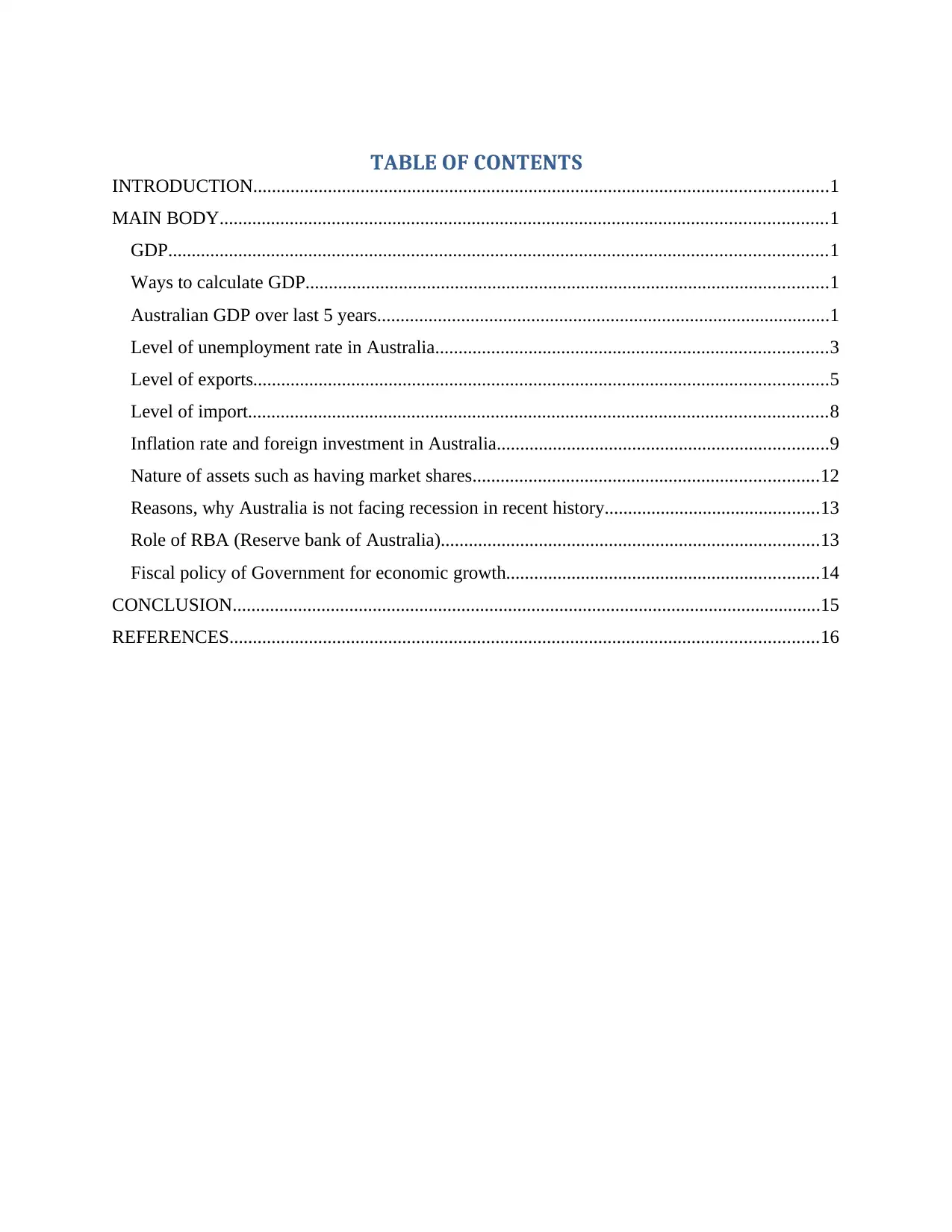
TABLE OF CONTENTS
INTRODUCTION...........................................................................................................................1
MAIN BODY..................................................................................................................................1
GDP.............................................................................................................................................1
Ways to calculate GDP................................................................................................................1
Australian GDP over last 5 years.................................................................................................1
Level of unemployment rate in Australia....................................................................................3
Level of exports...........................................................................................................................5
Level of import............................................................................................................................8
Inflation rate and foreign investment in Australia.......................................................................9
Nature of assets such as having market shares..........................................................................12
Reasons, why Australia is not facing recession in recent history..............................................13
Role of RBA (Reserve bank of Australia).................................................................................13
Fiscal policy of Government for economic growth...................................................................14
CONCLUSION..............................................................................................................................15
REFERENCES..............................................................................................................................16
INTRODUCTION...........................................................................................................................1
MAIN BODY..................................................................................................................................1
GDP.............................................................................................................................................1
Ways to calculate GDP................................................................................................................1
Australian GDP over last 5 years.................................................................................................1
Level of unemployment rate in Australia....................................................................................3
Level of exports...........................................................................................................................5
Level of import............................................................................................................................8
Inflation rate and foreign investment in Australia.......................................................................9
Nature of assets such as having market shares..........................................................................12
Reasons, why Australia is not facing recession in recent history..............................................13
Role of RBA (Reserve bank of Australia).................................................................................13
Fiscal policy of Government for economic growth...................................................................14
CONCLUSION..............................................................................................................................15
REFERENCES..............................................................................................................................16
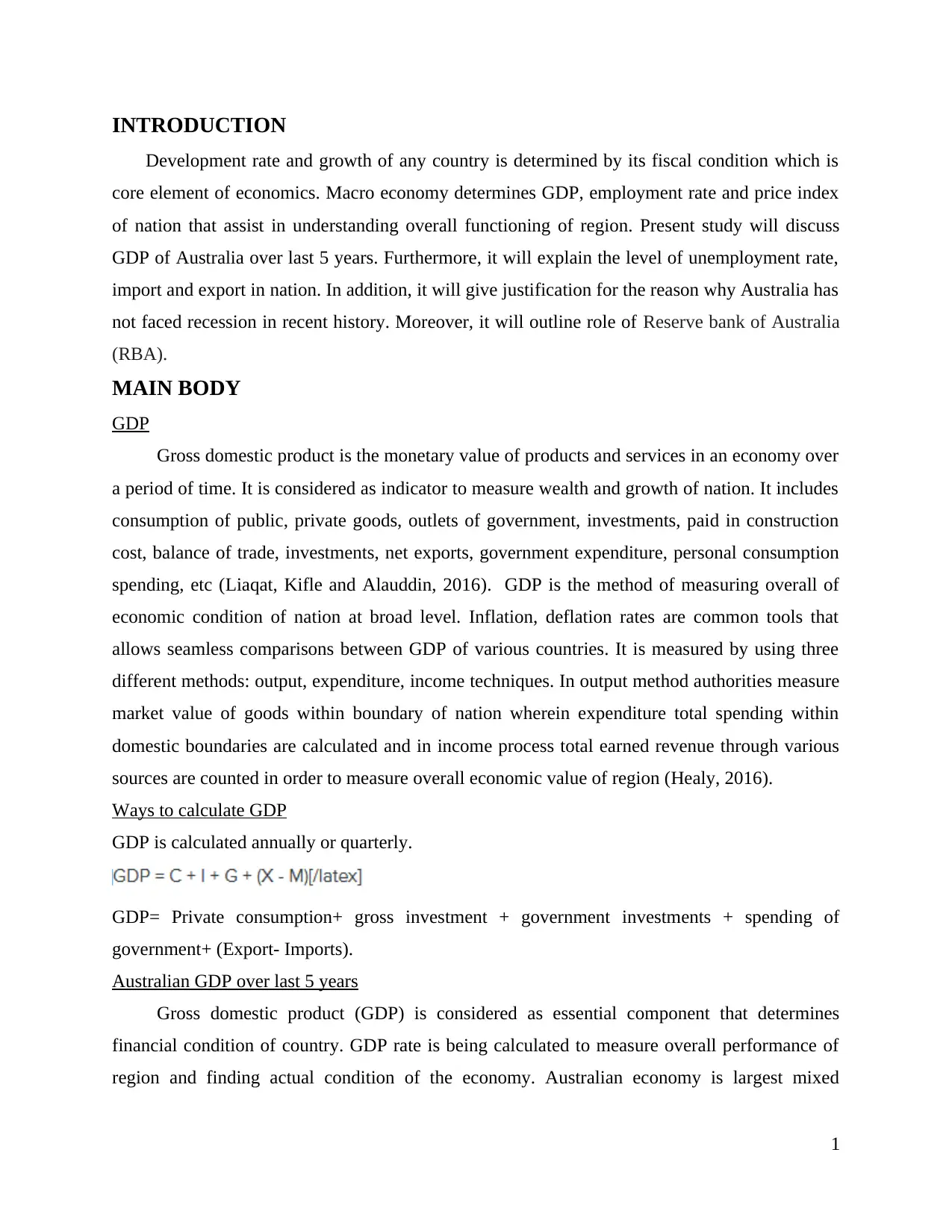
INTRODUCTION
Development rate and growth of any country is determined by its fiscal condition which is
core element of economics. Macro economy determines GDP, employment rate and price index
of nation that assist in understanding overall functioning of region. Present study will discuss
GDP of Australia over last 5 years. Furthermore, it will explain the level of unemployment rate,
import and export in nation. In addition, it will give justification for the reason why Australia has
not faced recession in recent history. Moreover, it will outline role of Reserve bank of Australia
(RBA).
MAIN BODY
GDP
Gross domestic product is the monetary value of products and services in an economy over
a period of time. It is considered as indicator to measure wealth and growth of nation. It includes
consumption of public, private goods, outlets of government, investments, paid in construction
cost, balance of trade, investments, net exports, government expenditure, personal consumption
spending, etc (Liaqat, Kifle and Alauddin, 2016). GDP is the method of measuring overall of
economic condition of nation at broad level. Inflation, deflation rates are common tools that
allows seamless comparisons between GDP of various countries. It is measured by using three
different methods: output, expenditure, income techniques. In output method authorities measure
market value of goods within boundary of nation wherein expenditure total spending within
domestic boundaries are calculated and in income process total earned revenue through various
sources are counted in order to measure overall economic value of region (Healy, 2016).
Ways to calculate GDP
GDP is calculated annually or quarterly.
GDP= Private consumption+ gross investment + government investments + spending of
government+ (Export- Imports).
Australian GDP over last 5 years
Gross domestic product (GDP) is considered as essential component that determines
financial condition of country. GDP rate is being calculated to measure overall performance of
region and finding actual condition of the economy. Australian economy is largest mixed
1
Development rate and growth of any country is determined by its fiscal condition which is
core element of economics. Macro economy determines GDP, employment rate and price index
of nation that assist in understanding overall functioning of region. Present study will discuss
GDP of Australia over last 5 years. Furthermore, it will explain the level of unemployment rate,
import and export in nation. In addition, it will give justification for the reason why Australia has
not faced recession in recent history. Moreover, it will outline role of Reserve bank of Australia
(RBA).
MAIN BODY
GDP
Gross domestic product is the monetary value of products and services in an economy over
a period of time. It is considered as indicator to measure wealth and growth of nation. It includes
consumption of public, private goods, outlets of government, investments, paid in construction
cost, balance of trade, investments, net exports, government expenditure, personal consumption
spending, etc (Liaqat, Kifle and Alauddin, 2016). GDP is the method of measuring overall of
economic condition of nation at broad level. Inflation, deflation rates are common tools that
allows seamless comparisons between GDP of various countries. It is measured by using three
different methods: output, expenditure, income techniques. In output method authorities measure
market value of goods within boundary of nation wherein expenditure total spending within
domestic boundaries are calculated and in income process total earned revenue through various
sources are counted in order to measure overall economic value of region (Healy, 2016).
Ways to calculate GDP
GDP is calculated annually or quarterly.
GDP= Private consumption+ gross investment + government investments + spending of
government+ (Export- Imports).
Australian GDP over last 5 years
Gross domestic product (GDP) is considered as essential component that determines
financial condition of country. GDP rate is being calculated to measure overall performance of
region and finding actual condition of the economy. Australian economy is largest mixed
1
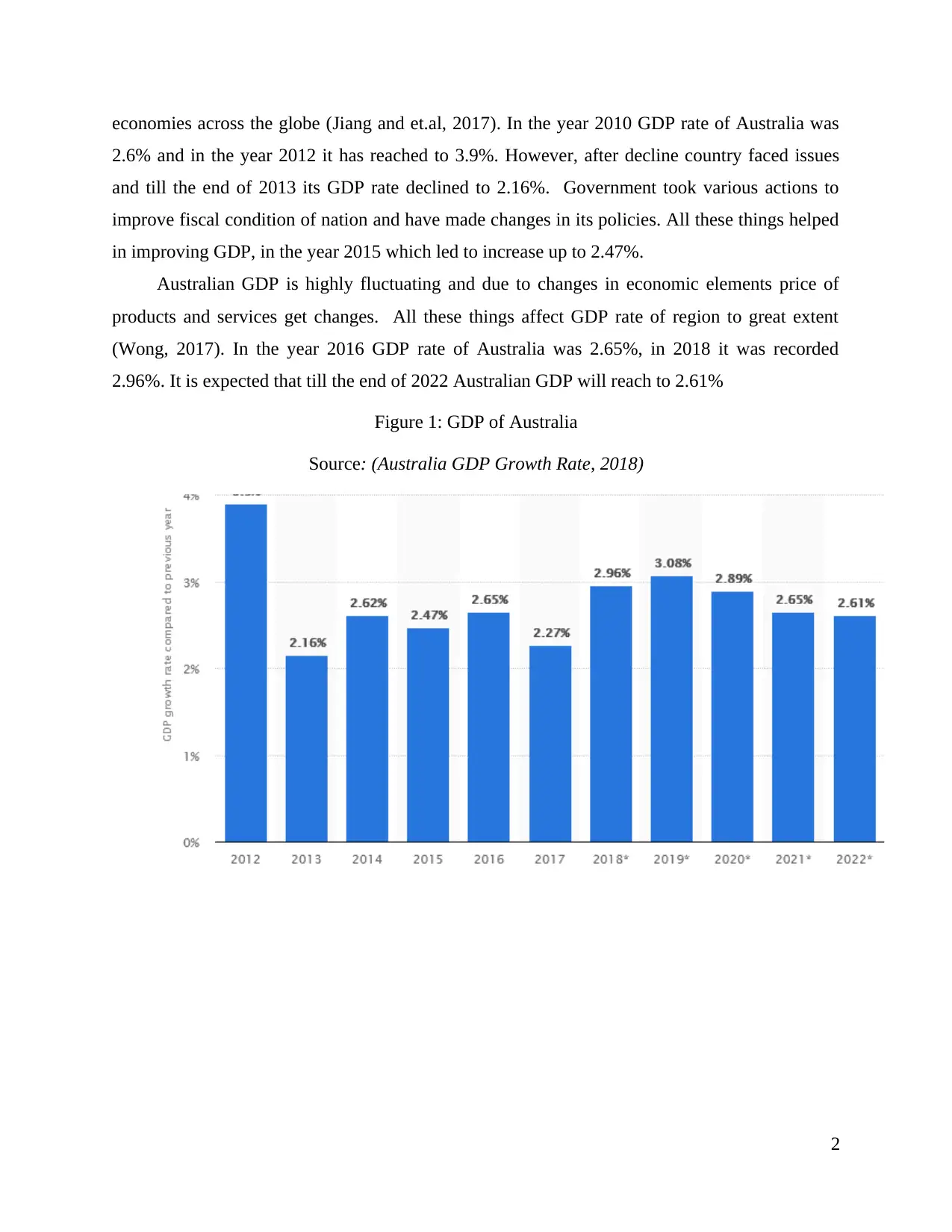
economies across the globe (Jiang and et.al, 2017). In the year 2010 GDP rate of Australia was
2.6% and in the year 2012 it has reached to 3.9%. However, after decline country faced issues
and till the end of 2013 its GDP rate declined to 2.16%. Government took various actions to
improve fiscal condition of nation and have made changes in its policies. All these things helped
in improving GDP, in the year 2015 which led to increase up to 2.47%.
Australian GDP is highly fluctuating and due to changes in economic elements price of
products and services get changes. All these things affect GDP rate of region to great extent
(Wong, 2017). In the year 2016 GDP rate of Australia was 2.65%, in 2018 it was recorded
2.96%. It is expected that till the end of 2022 Australian GDP will reach to 2.61%
Figure 1: GDP of Australia
Source: (Australia GDP Growth Rate, 2018)
2
2.6% and in the year 2012 it has reached to 3.9%. However, after decline country faced issues
and till the end of 2013 its GDP rate declined to 2.16%. Government took various actions to
improve fiscal condition of nation and have made changes in its policies. All these things helped
in improving GDP, in the year 2015 which led to increase up to 2.47%.
Australian GDP is highly fluctuating and due to changes in economic elements price of
products and services get changes. All these things affect GDP rate of region to great extent
(Wong, 2017). In the year 2016 GDP rate of Australia was 2.65%, in 2018 it was recorded
2.96%. It is expected that till the end of 2022 Australian GDP will reach to 2.61%
Figure 1: GDP of Australia
Source: (Australia GDP Growth Rate, 2018)
2
Secure Best Marks with AI Grader
Need help grading? Try our AI Grader for instant feedback on your assignments.
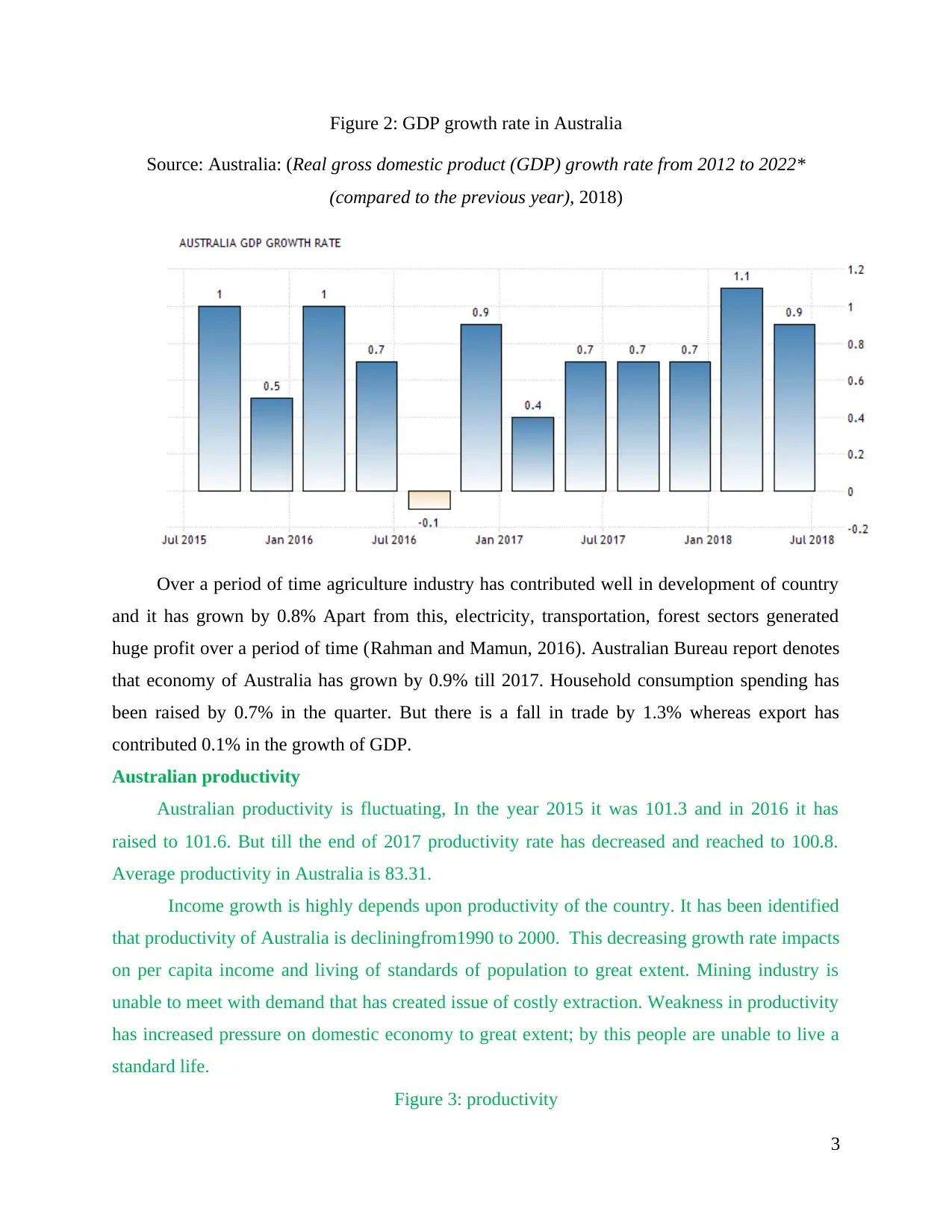
Figure 2: GDP growth rate in Australia
Source: Australia: (Real gross domestic product (GDP) growth rate from 2012 to 2022*
(compared to the previous year), 2018)
Over a period of time agriculture industry has contributed well in development of country
and it has grown by 0.8% Apart from this, electricity, transportation, forest sectors generated
huge profit over a period of time (Rahman and Mamun, 2016). Australian Bureau report denotes
that economy of Australia has grown by 0.9% till 2017. Household consumption spending has
been raised by 0.7% in the quarter. But there is a fall in trade by 1.3% whereas export has
contributed 0.1% in the growth of GDP.
Australian productivity
Australian productivity is fluctuating, In the year 2015 it was 101.3 and in 2016 it has
raised to 101.6. But till the end of 2017 productivity rate has decreased and reached to 100.8.
Average productivity in Australia is 83.31.
Income growth is highly depends upon productivity of the country. It has been identified
that productivity of Australia is decliningfrom1990 to 2000. This decreasing growth rate impacts
on per capita income and living of standards of population to great extent. Mining industry is
unable to meet with demand that has created issue of costly extraction. Weakness in productivity
has increased pressure on domestic economy to great extent; by this people are unable to live a
standard life.
Figure 3: productivity
3
Source: Australia: (Real gross domestic product (GDP) growth rate from 2012 to 2022*
(compared to the previous year), 2018)
Over a period of time agriculture industry has contributed well in development of country
and it has grown by 0.8% Apart from this, electricity, transportation, forest sectors generated
huge profit over a period of time (Rahman and Mamun, 2016). Australian Bureau report denotes
that economy of Australia has grown by 0.9% till 2017. Household consumption spending has
been raised by 0.7% in the quarter. But there is a fall in trade by 1.3% whereas export has
contributed 0.1% in the growth of GDP.
Australian productivity
Australian productivity is fluctuating, In the year 2015 it was 101.3 and in 2016 it has
raised to 101.6. But till the end of 2017 productivity rate has decreased and reached to 100.8.
Average productivity in Australia is 83.31.
Income growth is highly depends upon productivity of the country. It has been identified
that productivity of Australia is decliningfrom1990 to 2000. This decreasing growth rate impacts
on per capita income and living of standards of population to great extent. Mining industry is
unable to meet with demand that has created issue of costly extraction. Weakness in productivity
has increased pressure on domestic economy to great extent; by this people are unable to live a
standard life.
Figure 3: productivity
3
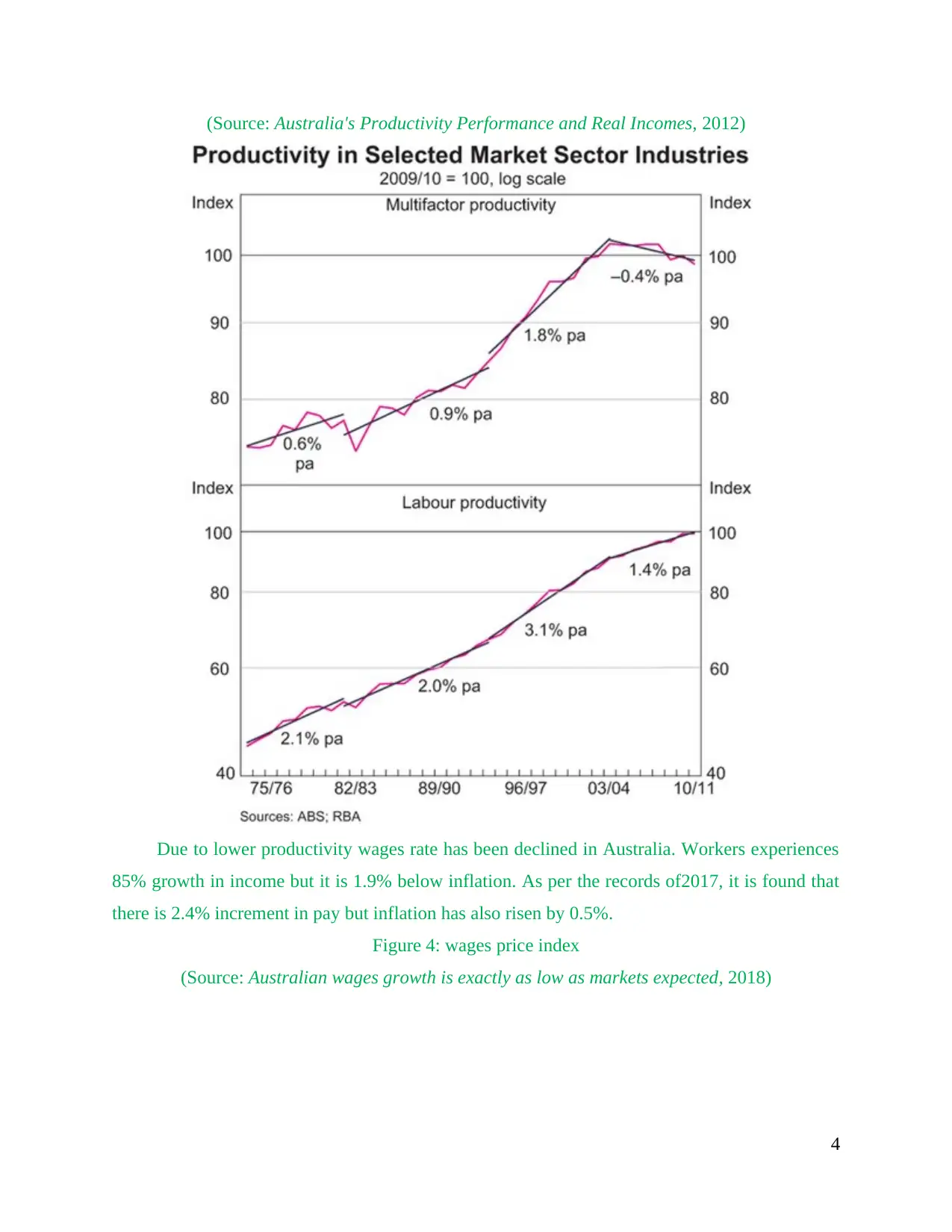
(Source: Australia's Productivity Performance and Real Incomes, 2012)
Due to lower productivity wages rate has been declined in Australia. Workers experiences
85% growth in income but it is 1.9% below inflation. As per the records of2017, it is found that
there is 2.4% increment in pay but inflation has also risen by 0.5%.
Figure 4: wages price index
(Source: Australian wages growth is exactly as low as markets expected, 2018)
4
Due to lower productivity wages rate has been declined in Australia. Workers experiences
85% growth in income but it is 1.9% below inflation. As per the records of2017, it is found that
there is 2.4% increment in pay but inflation has also risen by 0.5%.
Figure 4: wages price index
(Source: Australian wages growth is exactly as low as markets expected, 2018)
4
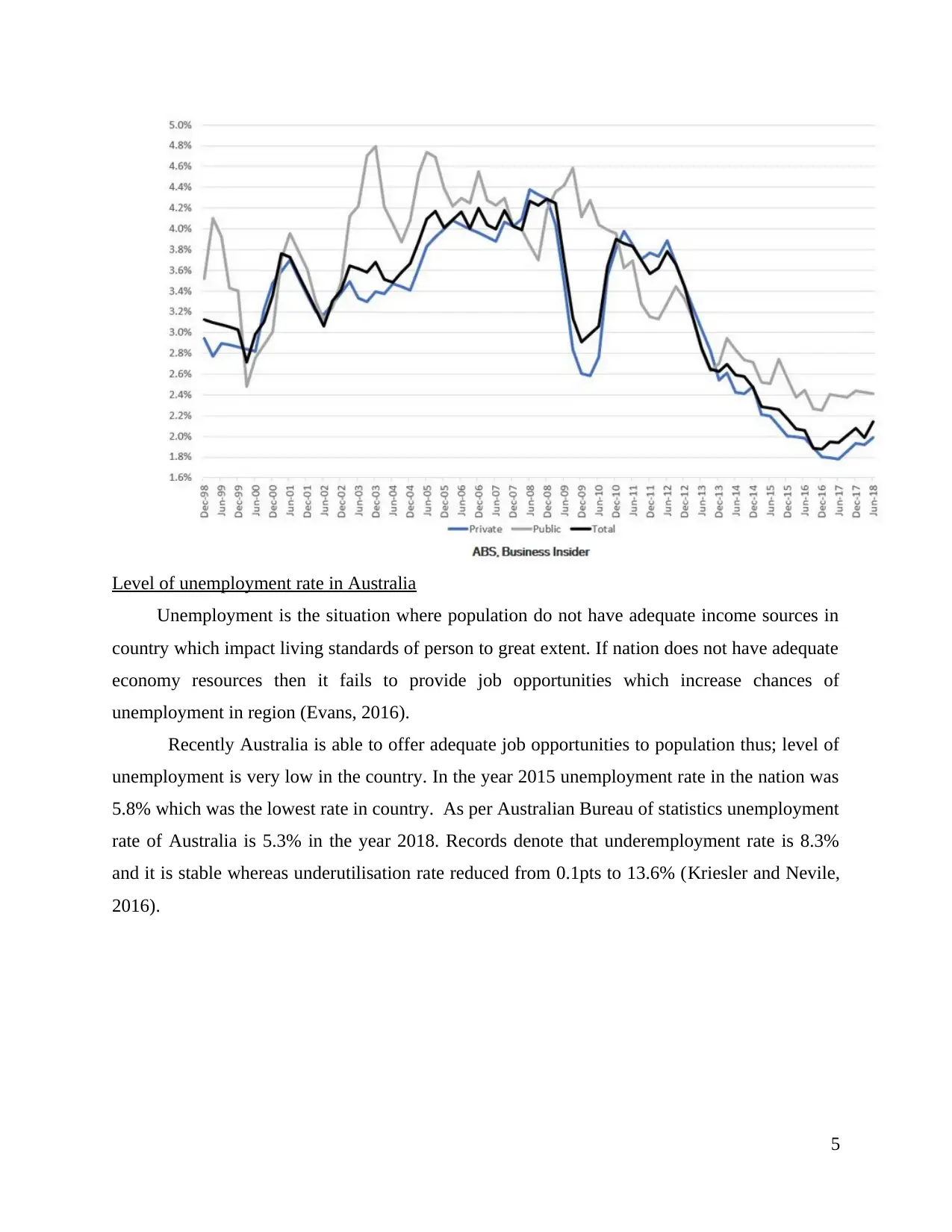
Level of unemployment rate in Australia
Unemployment is the situation where population do not have adequate income sources in
country which impact living standards of person to great extent. If nation does not have adequate
economy resources then it fails to provide job opportunities which increase chances of
unemployment in region (Evans, 2016).
Recently Australia is able to offer adequate job opportunities to population thus; level of
unemployment is very low in the country. In the year 2015 unemployment rate in the nation was
5.8% which was the lowest rate in country. As per Australian Bureau of statistics unemployment
rate of Australia is 5.3% in the year 2018. Records denote that underemployment rate is 8.3%
and it is stable whereas underutilisation rate reduced from 0.1pts to 13.6% (Kriesler and Nevile,
2016).
5
Unemployment is the situation where population do not have adequate income sources in
country which impact living standards of person to great extent. If nation does not have adequate
economy resources then it fails to provide job opportunities which increase chances of
unemployment in region (Evans, 2016).
Recently Australia is able to offer adequate job opportunities to population thus; level of
unemployment is very low in the country. In the year 2015 unemployment rate in the nation was
5.8% which was the lowest rate in country. As per Australian Bureau of statistics unemployment
rate of Australia is 5.3% in the year 2018. Records denote that underemployment rate is 8.3%
and it is stable whereas underutilisation rate reduced from 0.1pts to 13.6% (Kriesler and Nevile,
2016).
5
Paraphrase This Document
Need a fresh take? Get an instant paraphrase of this document with our AI Paraphraser
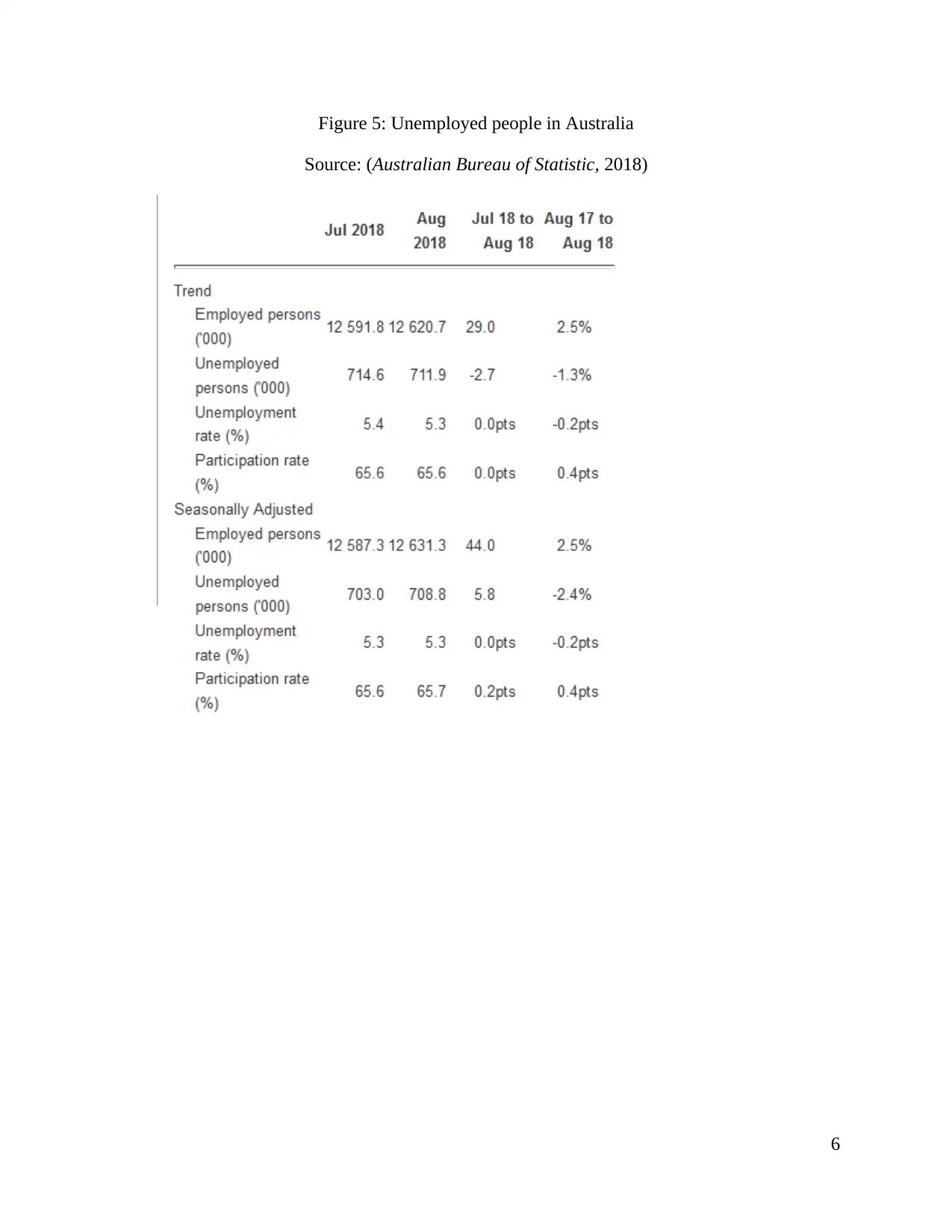
Figure 5: Unemployed people in Australia
Source: (Australian Bureau of Statistic, 2018)
6
Source: (Australian Bureau of Statistic, 2018)
6
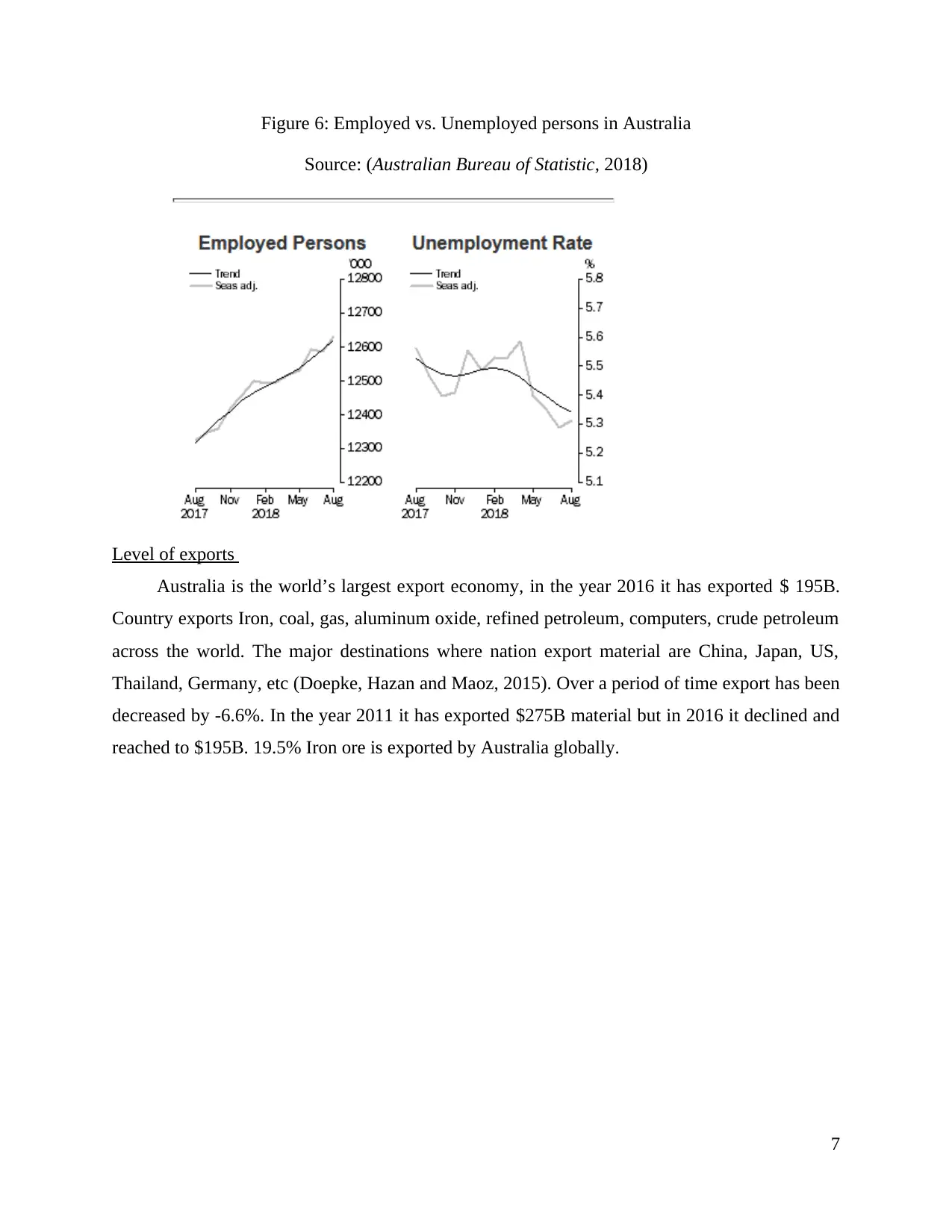
Figure 6: Employed vs. Unemployed persons in Australia
Source: (Australian Bureau of Statistic, 2018)
Level of exports
Australia is the world’s largest export economy, in the year 2016 it has exported $ 195B.
Country exports Iron, coal, gas, aluminum oxide, refined petroleum, computers, crude petroleum
across the world. The major destinations where nation export material are China, Japan, US,
Thailand, Germany, etc (Doepke, Hazan and Maoz, 2015). Over a period of time export has been
decreased by -6.6%. In the year 2011 it has exported $275B material but in 2016 it declined and
reached to $195B. 19.5% Iron ore is exported by Australia globally.
7
Source: (Australian Bureau of Statistic, 2018)
Level of exports
Australia is the world’s largest export economy, in the year 2016 it has exported $ 195B.
Country exports Iron, coal, gas, aluminum oxide, refined petroleum, computers, crude petroleum
across the world. The major destinations where nation export material are China, Japan, US,
Thailand, Germany, etc (Doepke, Hazan and Maoz, 2015). Over a period of time export has been
decreased by -6.6%. In the year 2011 it has exported $275B material but in 2016 it declined and
reached to $195B. 19.5% Iron ore is exported by Australia globally.
7
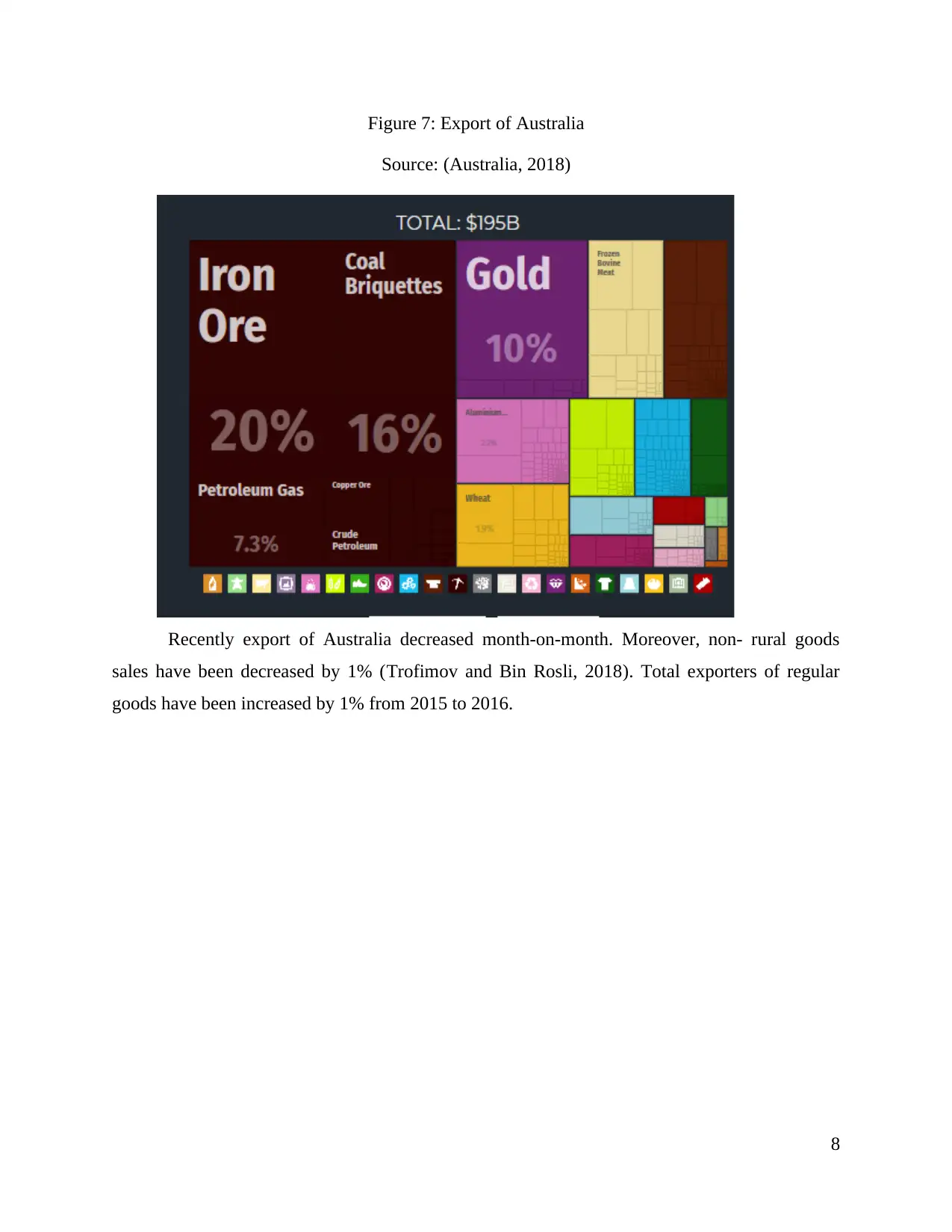
Figure 7: Export of Australia
Source: (Australia, 2018)
Recently export of Australia decreased month-on-month. Moreover, non- rural goods
sales have been decreased by 1% (Trofimov and Bin Rosli, 2018). Total exporters of regular
goods have been increased by 1% from 2015 to 2016.
8
Source: (Australia, 2018)
Recently export of Australia decreased month-on-month. Moreover, non- rural goods
sales have been decreased by 1% (Trofimov and Bin Rosli, 2018). Total exporters of regular
goods have been increased by 1% from 2015 to 2016.
8
Secure Best Marks with AI Grader
Need help grading? Try our AI Grader for instant feedback on your assignments.

Figure 8: Australia export
Source: (Australia Exports, 2018)
Figure 9: Export level
(Source: Australia’s export performance in 2015-16, 2017)
9
Source: (Australia Exports, 2018)
Figure 9: Export level
(Source: Australia’s export performance in 2015-16, 2017)
9

Level of import
Import of the condition is steady and is recorded at AUD34.52Billion. In the year 2016
total import of Australia was AUD187B. Country is 23rd largest importer but over a period of
time its level of import has been reduced. By -3.8% annually. In the year $229B worth material
were imported whereas in the year 2016 it has reached to $187B. Cars, refined petroleum are the
major import products of the nation (Nguyen and Duncan, 2015). Cars account 8.85% and
refined petroleum accounts 5.71%. In the year 2007 worth of import was $165.34, it has
increased in 2008 and has reached to $200.27 in that year. In 2017, import was AUD228.58B.
Figure 10: Import export of Australia
Source: (Australian Bureau of Statistics, 2018)
10
Import of the condition is steady and is recorded at AUD34.52Billion. In the year 2016
total import of Australia was AUD187B. Country is 23rd largest importer but over a period of
time its level of import has been reduced. By -3.8% annually. In the year $229B worth material
were imported whereas in the year 2016 it has reached to $187B. Cars, refined petroleum are the
major import products of the nation (Nguyen and Duncan, 2015). Cars account 8.85% and
refined petroleum accounts 5.71%. In the year 2007 worth of import was $165.34, it has
increased in 2008 and has reached to $200.27 in that year. In 2017, import was AUD228.58B.
Figure 10: Import export of Australia
Source: (Australian Bureau of Statistics, 2018)
10
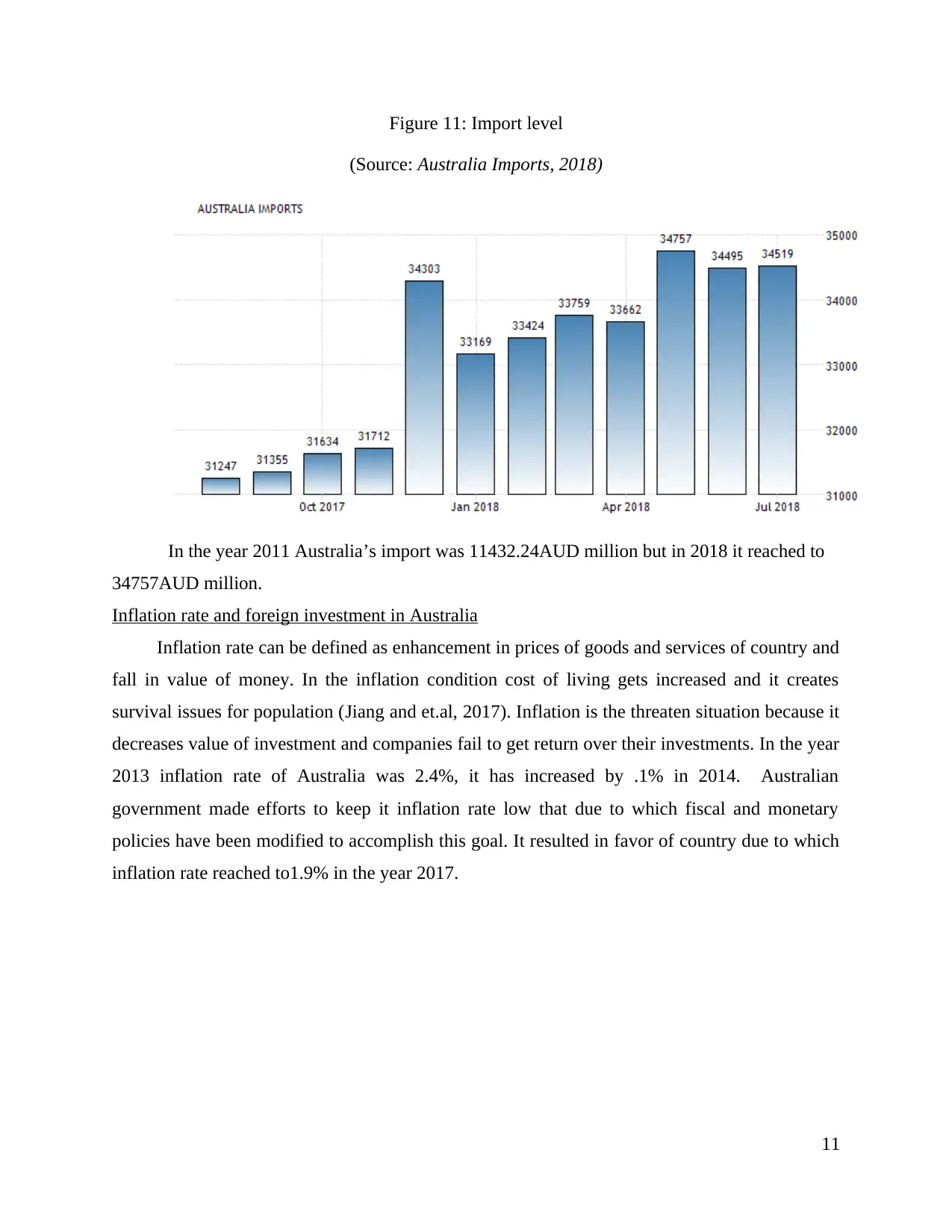
Figure 11: Import level
(Source: Australia Imports, 2018)
In the year 2011 Australia’s import was 11432.24AUD million but in 2018 it reached to
34757AUD million.
Inflation rate and foreign investment in Australia
Inflation rate can be defined as enhancement in prices of goods and services of country and
fall in value of money. In the inflation condition cost of living gets increased and it creates
survival issues for population (Jiang and et.al, 2017). Inflation is the threaten situation because it
decreases value of investment and companies fail to get return over their investments. In the year
2013 inflation rate of Australia was 2.4%, it has increased by .1% in 2014. Australian
government made efforts to keep it inflation rate low that due to which fiscal and monetary
policies have been modified to accomplish this goal. It resulted in favor of country due to which
inflation rate reached to1.9% in the year 2017.
11
(Source: Australia Imports, 2018)
In the year 2011 Australia’s import was 11432.24AUD million but in 2018 it reached to
34757AUD million.
Inflation rate and foreign investment in Australia
Inflation rate can be defined as enhancement in prices of goods and services of country and
fall in value of money. In the inflation condition cost of living gets increased and it creates
survival issues for population (Jiang and et.al, 2017). Inflation is the threaten situation because it
decreases value of investment and companies fail to get return over their investments. In the year
2013 inflation rate of Australia was 2.4%, it has increased by .1% in 2014. Australian
government made efforts to keep it inflation rate low that due to which fiscal and monetary
policies have been modified to accomplish this goal. It resulted in favor of country due to which
inflation rate reached to1.9% in the year 2017.
11
Paraphrase This Document
Need a fresh take? Get an instant paraphrase of this document with our AI Paraphraser
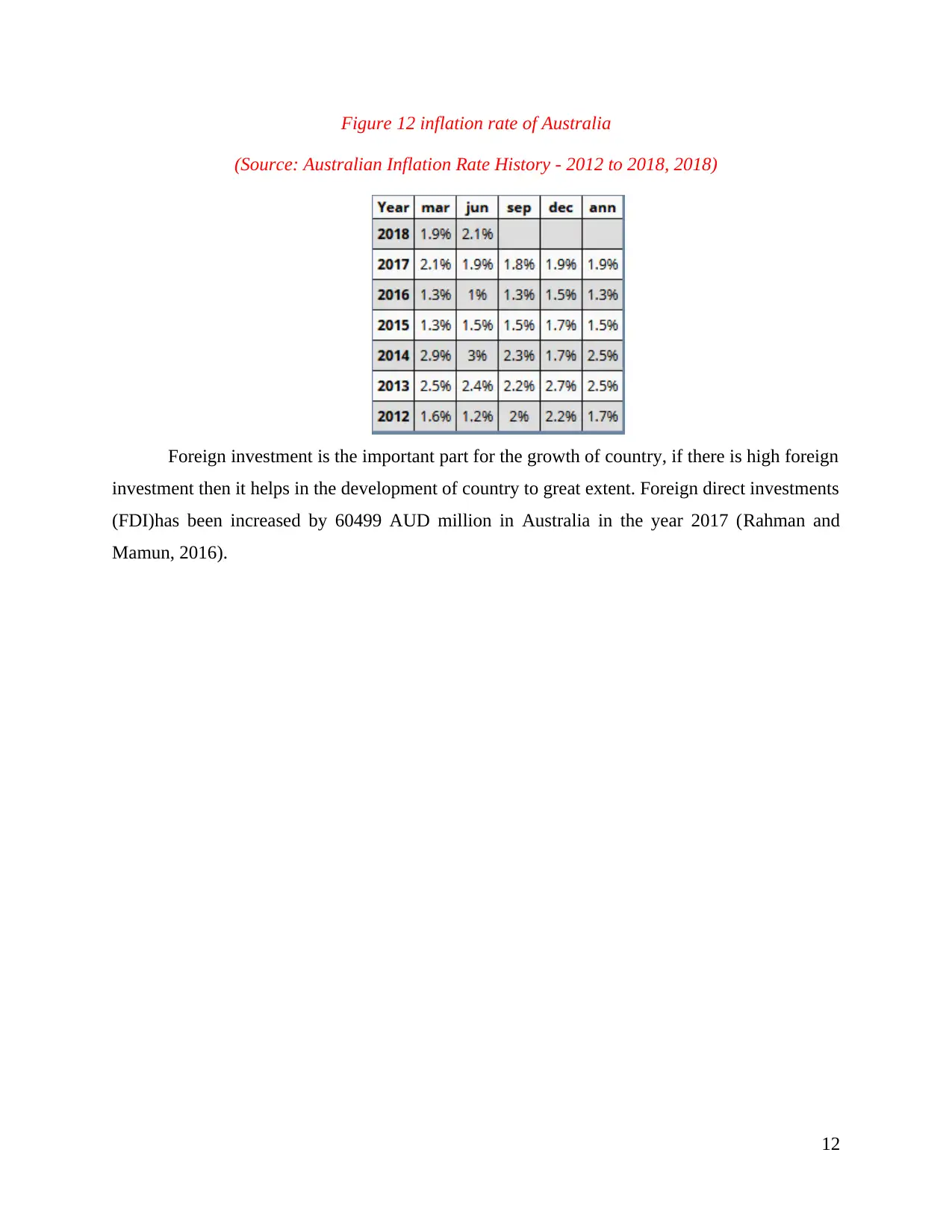
Figure 12 inflation rate of Australia
(Source: Australian Inflation Rate History - 2012 to 2018, 2018)
Foreign investment is the important part for the growth of country, if there is high foreign
investment then it helps in the development of country to great extent. Foreign direct investments
(FDI)has been increased by 60499 AUD million in Australia in the year 2017 (Rahman and
Mamun, 2016).
12
(Source: Australian Inflation Rate History - 2012 to 2018, 2018)
Foreign investment is the important part for the growth of country, if there is high foreign
investment then it helps in the development of country to great extent. Foreign direct investments
(FDI)has been increased by 60499 AUD million in Australia in the year 2017 (Rahman and
Mamun, 2016).
12
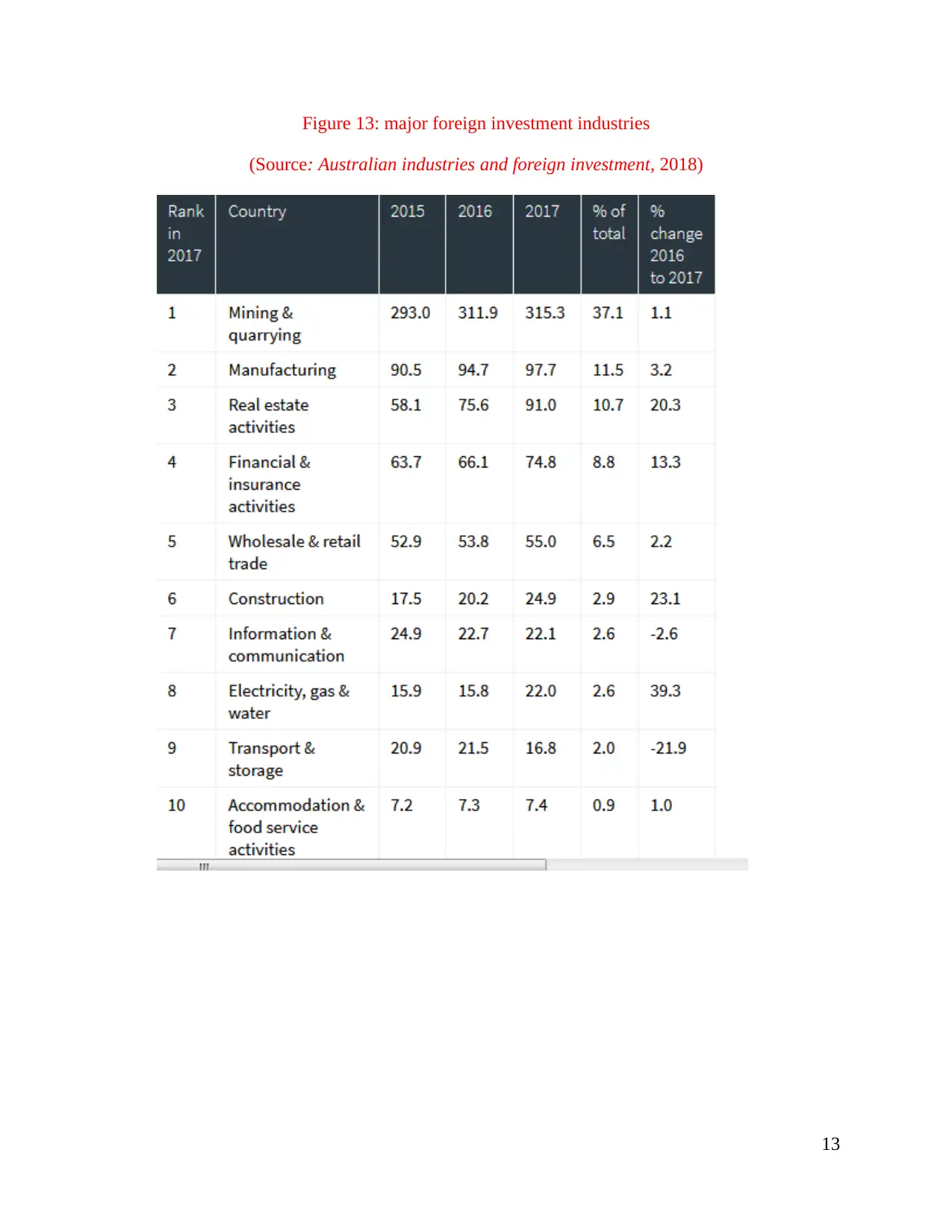
Figure 13: major foreign investment industries
(Source: Australian industries and foreign investment, 2018)
13
(Source: Australian industries and foreign investment, 2018)
13
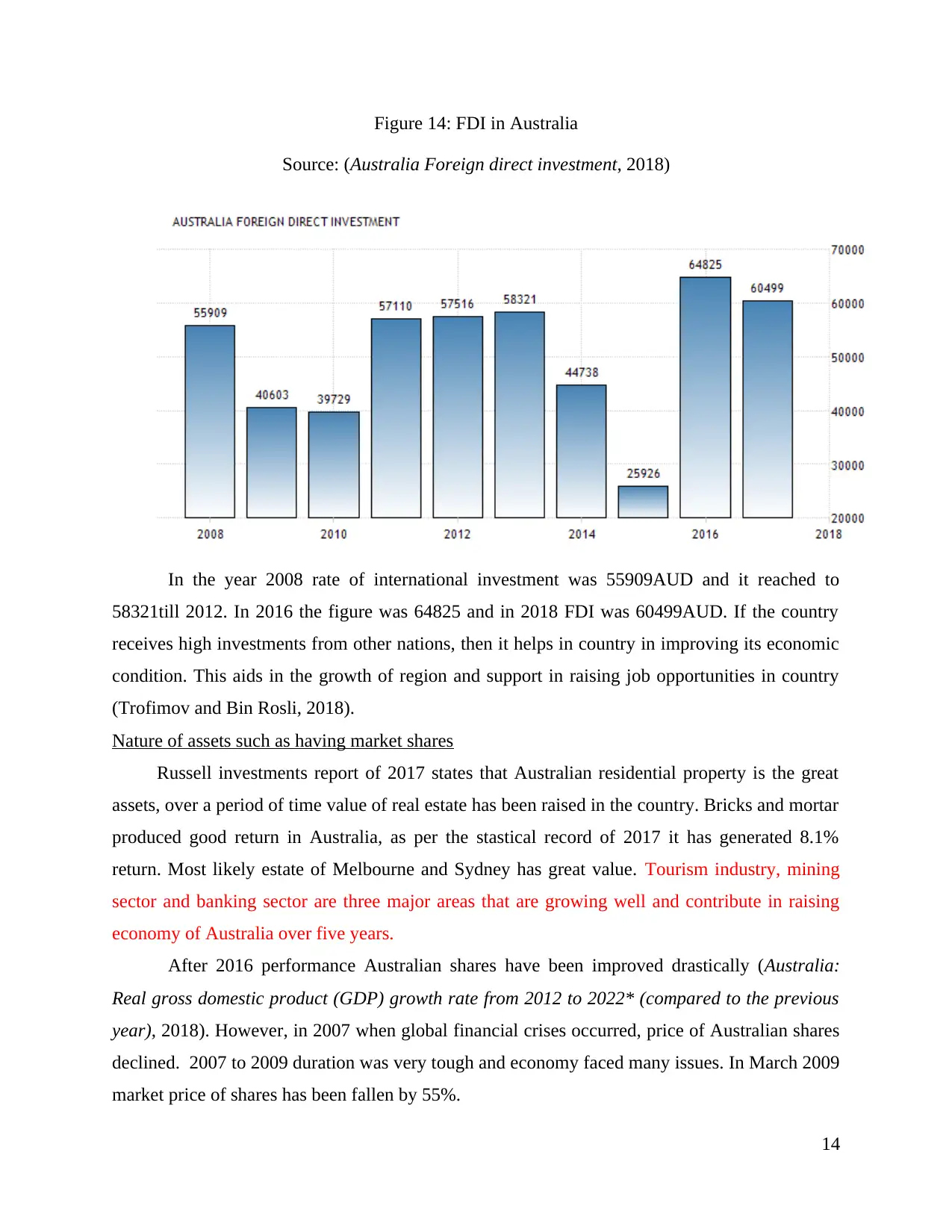
Figure 14: FDI in Australia
Source: (Australia Foreign direct investment, 2018)
In the year 2008 rate of international investment was 55909AUD and it reached to
58321till 2012. In 2016 the figure was 64825 and in 2018 FDI was 60499AUD. If the country
receives high investments from other nations, then it helps in country in improving its economic
condition. This aids in the growth of region and support in raising job opportunities in country
(Trofimov and Bin Rosli, 2018).
Nature of assets such as having market shares
Russell investments report of 2017 states that Australian residential property is the great
assets, over a period of time value of real estate has been raised in the country. Bricks and mortar
produced good return in Australia, as per the stastical record of 2017 it has generated 8.1%
return. Most likely estate of Melbourne and Sydney has great value. Tourism industry, mining
sector and banking sector are three major areas that are growing well and contribute in raising
economy of Australia over five years.
After 2016 performance Australian shares have been improved drastically (Australia:
Real gross domestic product (GDP) growth rate from 2012 to 2022* (compared to the previous
year), 2018). However, in 2007 when global financial crises occurred, price of Australian shares
declined. 2007 to 2009 duration was very tough and economy faced many issues. In March 2009
market price of shares has been fallen by 55%.
14
Source: (Australia Foreign direct investment, 2018)
In the year 2008 rate of international investment was 55909AUD and it reached to
58321till 2012. In 2016 the figure was 64825 and in 2018 FDI was 60499AUD. If the country
receives high investments from other nations, then it helps in country in improving its economic
condition. This aids in the growth of region and support in raising job opportunities in country
(Trofimov and Bin Rosli, 2018).
Nature of assets such as having market shares
Russell investments report of 2017 states that Australian residential property is the great
assets, over a period of time value of real estate has been raised in the country. Bricks and mortar
produced good return in Australia, as per the stastical record of 2017 it has generated 8.1%
return. Most likely estate of Melbourne and Sydney has great value. Tourism industry, mining
sector and banking sector are three major areas that are growing well and contribute in raising
economy of Australia over five years.
After 2016 performance Australian shares have been improved drastically (Australia:
Real gross domestic product (GDP) growth rate from 2012 to 2022* (compared to the previous
year), 2018). However, in 2007 when global financial crises occurred, price of Australian shares
declined. 2007 to 2009 duration was very tough and economy faced many issues. In March 2009
market price of shares has been fallen by 55%.
14
Secure Best Marks with AI Grader
Need help grading? Try our AI Grader for instant feedback on your assignments.
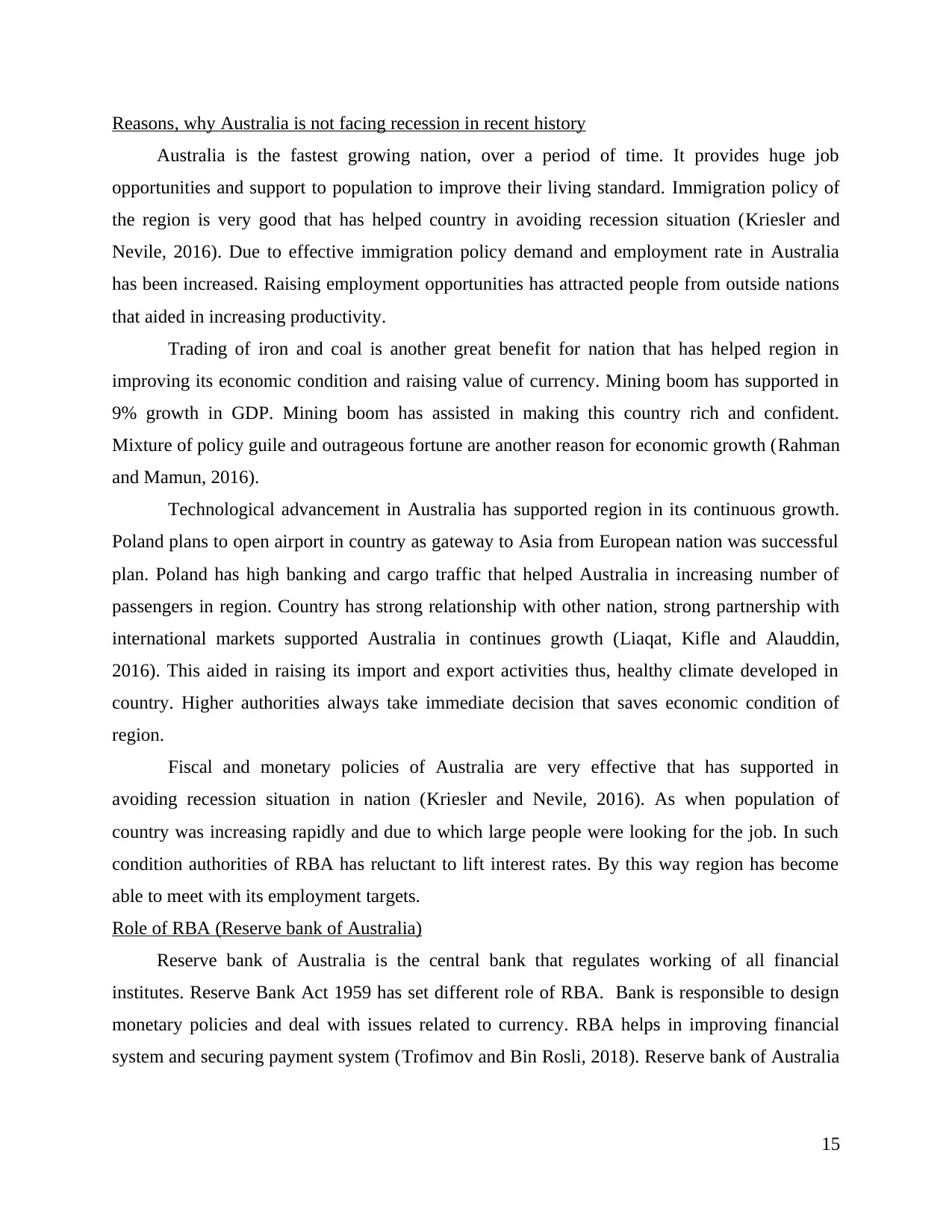
Reasons, why Australia is not facing recession in recent history
Australia is the fastest growing nation, over a period of time. It provides huge job
opportunities and support to population to improve their living standard. Immigration policy of
the region is very good that has helped country in avoiding recession situation (Kriesler and
Nevile, 2016). Due to effective immigration policy demand and employment rate in Australia
has been increased. Raising employment opportunities has attracted people from outside nations
that aided in increasing productivity.
Trading of iron and coal is another great benefit for nation that has helped region in
improving its economic condition and raising value of currency. Mining boom has supported in
9% growth in GDP. Mining boom has assisted in making this country rich and confident.
Mixture of policy guile and outrageous fortune are another reason for economic growth (Rahman
and Mamun, 2016).
Technological advancement in Australia has supported region in its continuous growth.
Poland plans to open airport in country as gateway to Asia from European nation was successful
plan. Poland has high banking and cargo traffic that helped Australia in increasing number of
passengers in region. Country has strong relationship with other nation, strong partnership with
international markets supported Australia in continues growth (Liaqat, Kifle and Alauddin,
2016). This aided in raising its import and export activities thus, healthy climate developed in
country. Higher authorities always take immediate decision that saves economic condition of
region.
Fiscal and monetary policies of Australia are very effective that has supported in
avoiding recession situation in nation (Kriesler and Nevile, 2016). As when population of
country was increasing rapidly and due to which large people were looking for the job. In such
condition authorities of RBA has reluctant to lift interest rates. By this way region has become
able to meet with its employment targets.
Role of RBA (Reserve bank of Australia)
Reserve bank of Australia is the central bank that regulates working of all financial
institutes. Reserve Bank Act 1959 has set different role of RBA. Bank is responsible to design
monetary policies and deal with issues related to currency. RBA helps in improving financial
system and securing payment system (Trofimov and Bin Rosli, 2018). Reserve bank of Australia
15
Australia is the fastest growing nation, over a period of time. It provides huge job
opportunities and support to population to improve their living standard. Immigration policy of
the region is very good that has helped country in avoiding recession situation (Kriesler and
Nevile, 2016). Due to effective immigration policy demand and employment rate in Australia
has been increased. Raising employment opportunities has attracted people from outside nations
that aided in increasing productivity.
Trading of iron and coal is another great benefit for nation that has helped region in
improving its economic condition and raising value of currency. Mining boom has supported in
9% growth in GDP. Mining boom has assisted in making this country rich and confident.
Mixture of policy guile and outrageous fortune are another reason for economic growth (Rahman
and Mamun, 2016).
Technological advancement in Australia has supported region in its continuous growth.
Poland plans to open airport in country as gateway to Asia from European nation was successful
plan. Poland has high banking and cargo traffic that helped Australia in increasing number of
passengers in region. Country has strong relationship with other nation, strong partnership with
international markets supported Australia in continues growth (Liaqat, Kifle and Alauddin,
2016). This aided in raising its import and export activities thus, healthy climate developed in
country. Higher authorities always take immediate decision that saves economic condition of
region.
Fiscal and monetary policies of Australia are very effective that has supported in
avoiding recession situation in nation (Kriesler and Nevile, 2016). As when population of
country was increasing rapidly and due to which large people were looking for the job. In such
condition authorities of RBA has reluctant to lift interest rates. By this way region has become
able to meet with its employment targets.
Role of RBA (Reserve bank of Australia)
Reserve bank of Australia is the central bank that regulates working of all financial
institutes. Reserve Bank Act 1959 has set different role of RBA. Bank is responsible to design
monetary policies and deal with issues related to currency. RBA helps in improving financial
system and securing payment system (Trofimov and Bin Rosli, 2018). Reserve bank of Australia
15
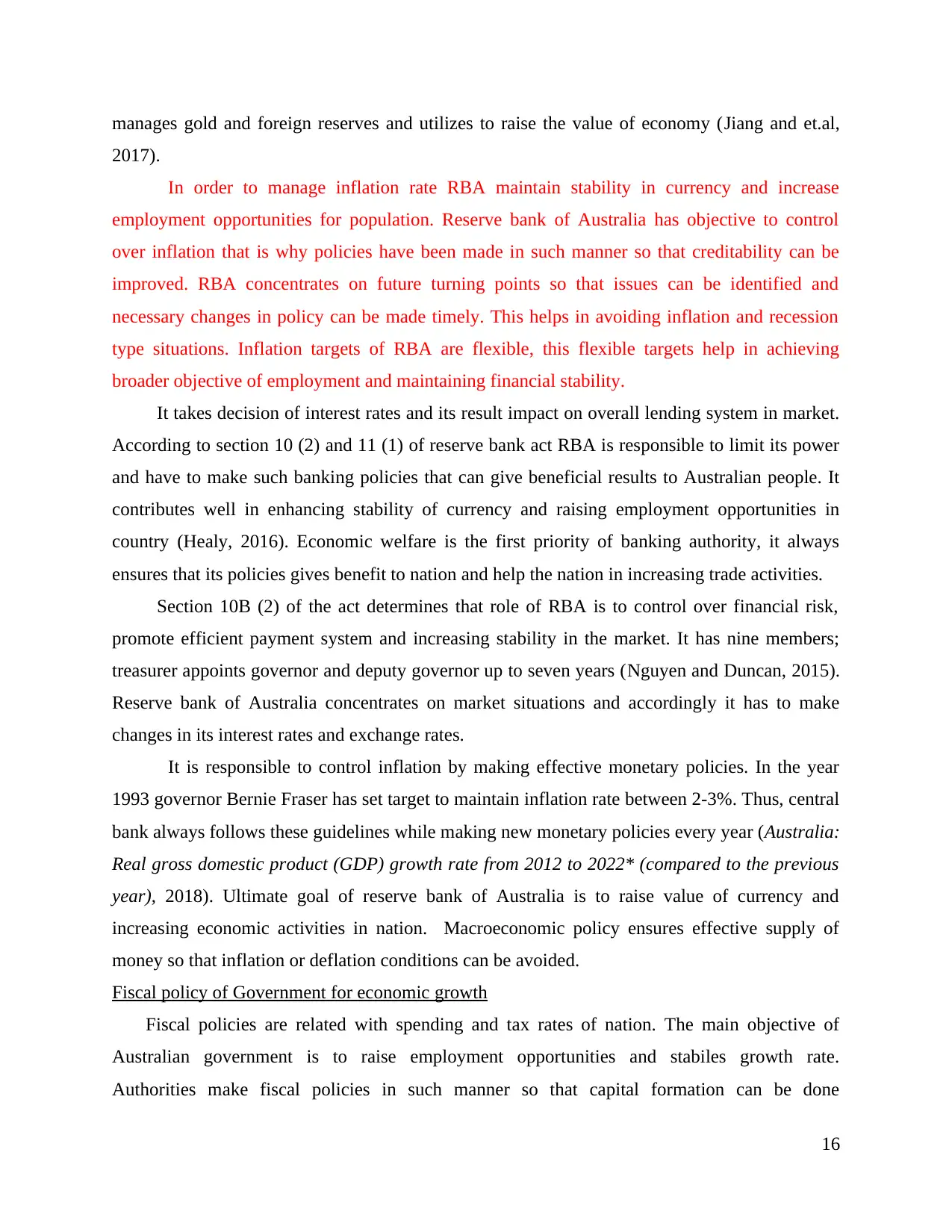
manages gold and foreign reserves and utilizes to raise the value of economy (Jiang and et.al,
2017).
In order to manage inflation rate RBA maintain stability in currency and increase
employment opportunities for population. Reserve bank of Australia has objective to control
over inflation that is why policies have been made in such manner so that creditability can be
improved. RBA concentrates on future turning points so that issues can be identified and
necessary changes in policy can be made timely. This helps in avoiding inflation and recession
type situations. Inflation targets of RBA are flexible, this flexible targets help in achieving
broader objective of employment and maintaining financial stability.
It takes decision of interest rates and its result impact on overall lending system in market.
According to section 10 (2) and 11 (1) of reserve bank act RBA is responsible to limit its power
and have to make such banking policies that can give beneficial results to Australian people. It
contributes well in enhancing stability of currency and raising employment opportunities in
country (Healy, 2016). Economic welfare is the first priority of banking authority, it always
ensures that its policies gives benefit to nation and help the nation in increasing trade activities.
Section 10B (2) of the act determines that role of RBA is to control over financial risk,
promote efficient payment system and increasing stability in the market. It has nine members;
treasurer appoints governor and deputy governor up to seven years (Nguyen and Duncan, 2015).
Reserve bank of Australia concentrates on market situations and accordingly it has to make
changes in its interest rates and exchange rates.
It is responsible to control inflation by making effective monetary policies. In the year
1993 governor Bernie Fraser has set target to maintain inflation rate between 2-3%. Thus, central
bank always follows these guidelines while making new monetary policies every year (Australia:
Real gross domestic product (GDP) growth rate from 2012 to 2022* (compared to the previous
year), 2018). Ultimate goal of reserve bank of Australia is to raise value of currency and
increasing economic activities in nation. Macroeconomic policy ensures effective supply of
money so that inflation or deflation conditions can be avoided.
Fiscal policy of Government for economic growth
Fiscal policies are related with spending and tax rates of nation. The main objective of
Australian government is to raise employment opportunities and stabiles growth rate.
Authorities make fiscal policies in such manner so that capital formation can be done
16
2017).
In order to manage inflation rate RBA maintain stability in currency and increase
employment opportunities for population. Reserve bank of Australia has objective to control
over inflation that is why policies have been made in such manner so that creditability can be
improved. RBA concentrates on future turning points so that issues can be identified and
necessary changes in policy can be made timely. This helps in avoiding inflation and recession
type situations. Inflation targets of RBA are flexible, this flexible targets help in achieving
broader objective of employment and maintaining financial stability.
It takes decision of interest rates and its result impact on overall lending system in market.
According to section 10 (2) and 11 (1) of reserve bank act RBA is responsible to limit its power
and have to make such banking policies that can give beneficial results to Australian people. It
contributes well in enhancing stability of currency and raising employment opportunities in
country (Healy, 2016). Economic welfare is the first priority of banking authority, it always
ensures that its policies gives benefit to nation and help the nation in increasing trade activities.
Section 10B (2) of the act determines that role of RBA is to control over financial risk,
promote efficient payment system and increasing stability in the market. It has nine members;
treasurer appoints governor and deputy governor up to seven years (Nguyen and Duncan, 2015).
Reserve bank of Australia concentrates on market situations and accordingly it has to make
changes in its interest rates and exchange rates.
It is responsible to control inflation by making effective monetary policies. In the year
1993 governor Bernie Fraser has set target to maintain inflation rate between 2-3%. Thus, central
bank always follows these guidelines while making new monetary policies every year (Australia:
Real gross domestic product (GDP) growth rate from 2012 to 2022* (compared to the previous
year), 2018). Ultimate goal of reserve bank of Australia is to raise value of currency and
increasing economic activities in nation. Macroeconomic policy ensures effective supply of
money so that inflation or deflation conditions can be avoided.
Fiscal policy of Government for economic growth
Fiscal policies are related with spending and tax rates of nation. The main objective of
Australian government is to raise employment opportunities and stabiles growth rate.
Authorities make fiscal policies in such manner so that capital formation can be done
16
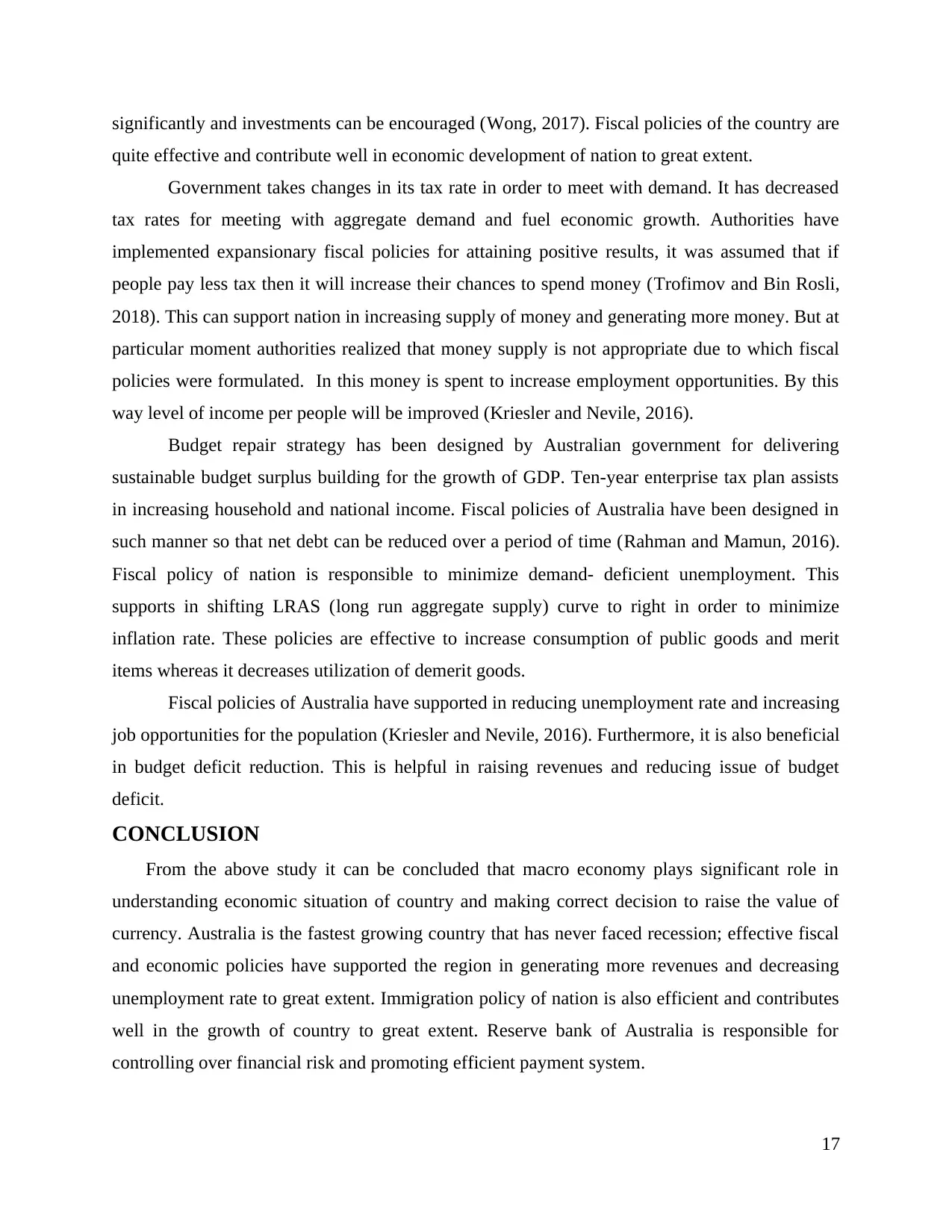
significantly and investments can be encouraged (Wong, 2017). Fiscal policies of the country are
quite effective and contribute well in economic development of nation to great extent.
Government takes changes in its tax rate in order to meet with demand. It has decreased
tax rates for meeting with aggregate demand and fuel economic growth. Authorities have
implemented expansionary fiscal policies for attaining positive results, it was assumed that if
people pay less tax then it will increase their chances to spend money (Trofimov and Bin Rosli,
2018). This can support nation in increasing supply of money and generating more money. But at
particular moment authorities realized that money supply is not appropriate due to which fiscal
policies were formulated. In this money is spent to increase employment opportunities. By this
way level of income per people will be improved (Kriesler and Nevile, 2016).
Budget repair strategy has been designed by Australian government for delivering
sustainable budget surplus building for the growth of GDP. Ten-year enterprise tax plan assists
in increasing household and national income. Fiscal policies of Australia have been designed in
such manner so that net debt can be reduced over a period of time (Rahman and Mamun, 2016).
Fiscal policy of nation is responsible to minimize demand- deficient unemployment. This
supports in shifting LRAS (long run aggregate supply) curve to right in order to minimize
inflation rate. These policies are effective to increase consumption of public goods and merit
items whereas it decreases utilization of demerit goods.
Fiscal policies of Australia have supported in reducing unemployment rate and increasing
job opportunities for the population (Kriesler and Nevile, 2016). Furthermore, it is also beneficial
in budget deficit reduction. This is helpful in raising revenues and reducing issue of budget
deficit.
CONCLUSION
From the above study it can be concluded that macro economy plays significant role in
understanding economic situation of country and making correct decision to raise the value of
currency. Australia is the fastest growing country that has never faced recession; effective fiscal
and economic policies have supported the region in generating more revenues and decreasing
unemployment rate to great extent. Immigration policy of nation is also efficient and contributes
well in the growth of country to great extent. Reserve bank of Australia is responsible for
controlling over financial risk and promoting efficient payment system.
17
quite effective and contribute well in economic development of nation to great extent.
Government takes changes in its tax rate in order to meet with demand. It has decreased
tax rates for meeting with aggregate demand and fuel economic growth. Authorities have
implemented expansionary fiscal policies for attaining positive results, it was assumed that if
people pay less tax then it will increase their chances to spend money (Trofimov and Bin Rosli,
2018). This can support nation in increasing supply of money and generating more money. But at
particular moment authorities realized that money supply is not appropriate due to which fiscal
policies were formulated. In this money is spent to increase employment opportunities. By this
way level of income per people will be improved (Kriesler and Nevile, 2016).
Budget repair strategy has been designed by Australian government for delivering
sustainable budget surplus building for the growth of GDP. Ten-year enterprise tax plan assists
in increasing household and national income. Fiscal policies of Australia have been designed in
such manner so that net debt can be reduced over a period of time (Rahman and Mamun, 2016).
Fiscal policy of nation is responsible to minimize demand- deficient unemployment. This
supports in shifting LRAS (long run aggregate supply) curve to right in order to minimize
inflation rate. These policies are effective to increase consumption of public goods and merit
items whereas it decreases utilization of demerit goods.
Fiscal policies of Australia have supported in reducing unemployment rate and increasing
job opportunities for the population (Kriesler and Nevile, 2016). Furthermore, it is also beneficial
in budget deficit reduction. This is helpful in raising revenues and reducing issue of budget
deficit.
CONCLUSION
From the above study it can be concluded that macro economy plays significant role in
understanding economic situation of country and making correct decision to raise the value of
currency. Australia is the fastest growing country that has never faced recession; effective fiscal
and economic policies have supported the region in generating more revenues and decreasing
unemployment rate to great extent. Immigration policy of nation is also efficient and contributes
well in the growth of country to great extent. Reserve bank of Australia is responsible for
controlling over financial risk and promoting efficient payment system.
17
Paraphrase This Document
Need a fresh take? Get an instant paraphrase of this document with our AI Paraphraser

REFERENCES
Books and Journals
Doepke, M., Hazan, M. & Maoz, Y. D., (2015). The baby boom and World War II: A
macroeconomic analysis. The Review of Economic Studies. 82(3). pp.1031-1073.
Evans, M. C., (2016). Deforestation in Australia: drivers, trends and policy responses. Pacific
Conservation Biology. 22(2). pp.130-150.
Healy, J., (2016). The Australian labour market in 2015. Journal of Industrial Relations. 58(3).
pp.308-323.
Jiang, B., Athanasopoulos, G., Hyndman, R. J., Panagiotelis, A., & Vahid, F. (2017).
Macroeconomic forecasting for Australia using a large number of predictors. Monash
Econometrics and Business Statistics Working Papers. 2. 17.
Kriesler, P. & Nevile, J. W., (2016). Macroeconomic impacts of globalization. In Post-Keynesian
Essays from Down Under Volume II: Essays on Policy and Applied Economics (pp. 32-
47). Palgrave Macmillan, London.
Liaqat, S., Kifle, T. & Alauddin, M., (2016). Aid-Macroeconomic Policy Environment-Growth
Nexus: Evidence from Selected Asian Countries (No. 565).
Nguyen, H. & Duncan, A., (2015). Macroeconomic fluctuations in home countries and
immigrants’ well-being: New evidence from Down Under.
Rahman, M. M. & Mamun, S. A. K., (2016). Energy use, international trade and economic
growth nexus in Australia: New evidence from an extended growth model. Renewable
and Sustainable Energy Reviews. 64. pp.806-816.
Trofimov, I. D. & Bin Rosli, M. K., (2018). Macroeconomic Determinants of the Labour Share
of Income: Evidence from OECD Economies.
Wong, W. W., (2017). The macroeconomic forces that drive REIT returns in Australia. Reviewed
Papers.
Online
Australia Exports. (2018). [Online]. Available through <
https://tradingeconomics.com/australia/exports >
Australia Foreign direct investment. (2018). [Online]. Available through <
https://tradingeconomics.com/australia/foreign-direct-investment>
Australia GDP Growth Rate. (2018). [Online]. Available through <
https://tradingeconomics.com/australia/gdp-growth>
Australia Imports. (2018). [Online]. Available through
https://tradingeconomics.com/australia/imports
Australia. (2018). [Online]. Available through <
https://atlas.media.mit.edu/en/profile/country/aus/#Exports >
Australia: Real gross domestic product (GDP) growth rate from 2012 to 2022* (compared to the
previous year). (2018). [Online]. Available through <
https://www.statista.com/statistics/263602/gross-domestic-product-gdp-growth-rate-in-
australia/>
18
Books and Journals
Doepke, M., Hazan, M. & Maoz, Y. D., (2015). The baby boom and World War II: A
macroeconomic analysis. The Review of Economic Studies. 82(3). pp.1031-1073.
Evans, M. C., (2016). Deforestation in Australia: drivers, trends and policy responses. Pacific
Conservation Biology. 22(2). pp.130-150.
Healy, J., (2016). The Australian labour market in 2015. Journal of Industrial Relations. 58(3).
pp.308-323.
Jiang, B., Athanasopoulos, G., Hyndman, R. J., Panagiotelis, A., & Vahid, F. (2017).
Macroeconomic forecasting for Australia using a large number of predictors. Monash
Econometrics and Business Statistics Working Papers. 2. 17.
Kriesler, P. & Nevile, J. W., (2016). Macroeconomic impacts of globalization. In Post-Keynesian
Essays from Down Under Volume II: Essays on Policy and Applied Economics (pp. 32-
47). Palgrave Macmillan, London.
Liaqat, S., Kifle, T. & Alauddin, M., (2016). Aid-Macroeconomic Policy Environment-Growth
Nexus: Evidence from Selected Asian Countries (No. 565).
Nguyen, H. & Duncan, A., (2015). Macroeconomic fluctuations in home countries and
immigrants’ well-being: New evidence from Down Under.
Rahman, M. M. & Mamun, S. A. K., (2016). Energy use, international trade and economic
growth nexus in Australia: New evidence from an extended growth model. Renewable
and Sustainable Energy Reviews. 64. pp.806-816.
Trofimov, I. D. & Bin Rosli, M. K., (2018). Macroeconomic Determinants of the Labour Share
of Income: Evidence from OECD Economies.
Wong, W. W., (2017). The macroeconomic forces that drive REIT returns in Australia. Reviewed
Papers.
Online
Australia Exports. (2018). [Online]. Available through <
https://tradingeconomics.com/australia/exports >
Australia Foreign direct investment. (2018). [Online]. Available through <
https://tradingeconomics.com/australia/foreign-direct-investment>
Australia GDP Growth Rate. (2018). [Online]. Available through <
https://tradingeconomics.com/australia/gdp-growth>
Australia Imports. (2018). [Online]. Available through
https://tradingeconomics.com/australia/imports
Australia. (2018). [Online]. Available through <
https://atlas.media.mit.edu/en/profile/country/aus/#Exports >
Australia: Real gross domestic product (GDP) growth rate from 2012 to 2022* (compared to the
previous year). (2018). [Online]. Available through <
https://www.statista.com/statistics/263602/gross-domestic-product-gdp-growth-rate-in-
australia/>
18
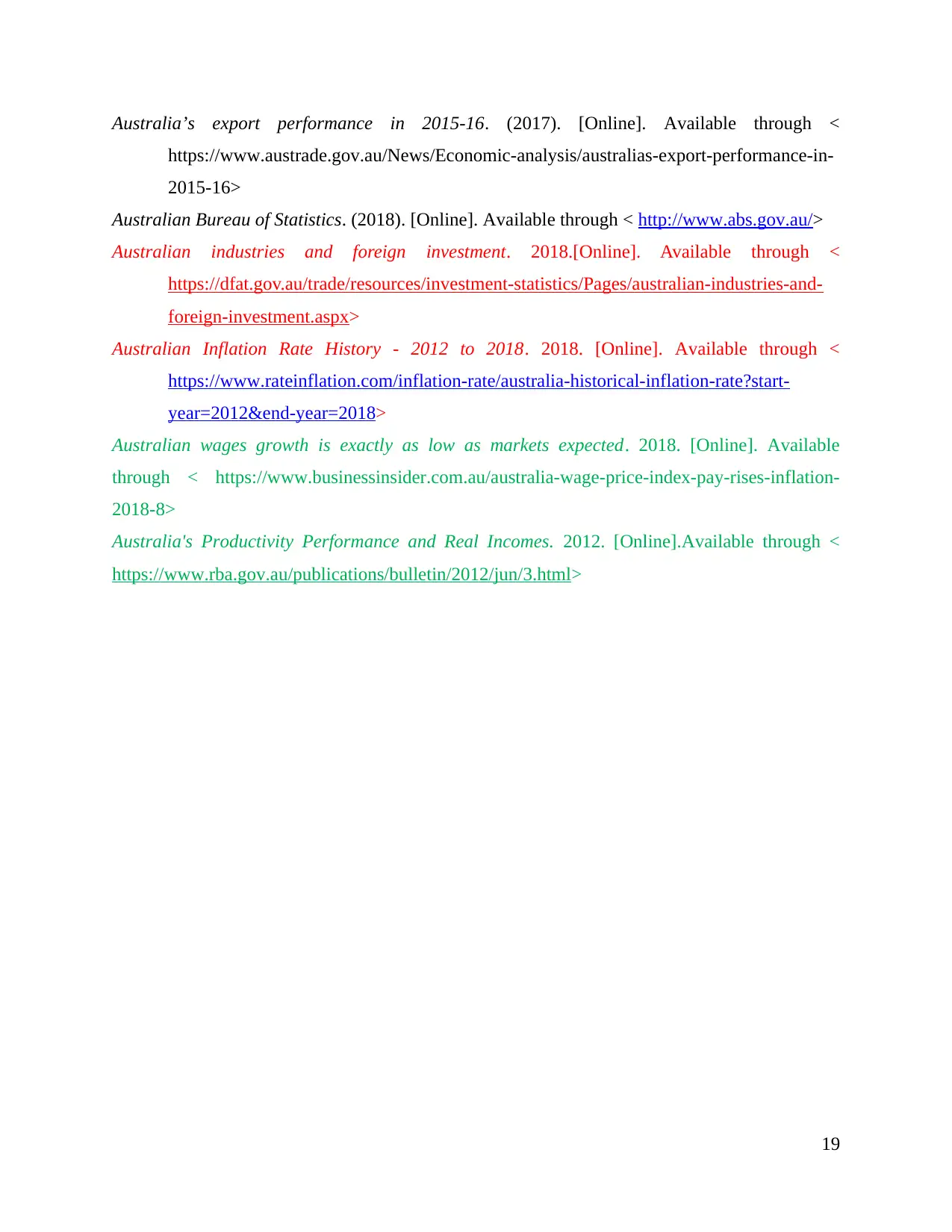
Australia’s export performance in 2015-16. (2017). [Online]. Available through <
https://www.austrade.gov.au/News/Economic-analysis/australias-export-performance-in-
2015-16>
Australian Bureau of Statistics. (2018). [Online]. Available through < http://www.abs.gov.au/>
Australian industries and foreign investment. 2018.[Online]. Available through <
https://dfat.gov.au/trade/resources/investment-statistics/Pages/australian-industries-and-
foreign-investment.aspx>
Australian Inflation Rate History - 2012 to 2018. 2018. [Online]. Available through <
https://www.rateinflation.com/inflation-rate/australia-historical-inflation-rate?start-
year=2012&end-year=2018>
Australian wages growth is exactly as low as markets expected. 2018. [Online]. Available
through < https://www.businessinsider.com.au/australia-wage-price-index-pay-rises-inflation-
2018-8>
Australia's Productivity Performance and Real Incomes. 2012. [Online].Available through <
https://www.rba.gov.au/publications/bulletin/2012/jun/3.html>
19
https://www.austrade.gov.au/News/Economic-analysis/australias-export-performance-in-
2015-16>
Australian Bureau of Statistics. (2018). [Online]. Available through < http://www.abs.gov.au/>
Australian industries and foreign investment. 2018.[Online]. Available through <
https://dfat.gov.au/trade/resources/investment-statistics/Pages/australian-industries-and-
foreign-investment.aspx>
Australian Inflation Rate History - 2012 to 2018. 2018. [Online]. Available through <
https://www.rateinflation.com/inflation-rate/australia-historical-inflation-rate?start-
year=2012&end-year=2018>
Australian wages growth is exactly as low as markets expected. 2018. [Online]. Available
through < https://www.businessinsider.com.au/australia-wage-price-index-pay-rises-inflation-
2018-8>
Australia's Productivity Performance and Real Incomes. 2012. [Online].Available through <
https://www.rba.gov.au/publications/bulletin/2012/jun/3.html>
19
1 out of 21
Related Documents
Your All-in-One AI-Powered Toolkit for Academic Success.
+13062052269
info@desklib.com
Available 24*7 on WhatsApp / Email
![[object Object]](/_next/static/media/star-bottom.7253800d.svg)
Unlock your academic potential
© 2024 | Zucol Services PVT LTD | All rights reserved.



